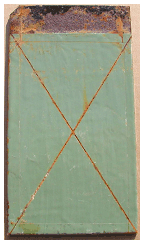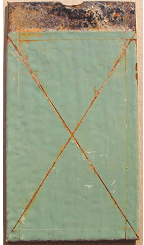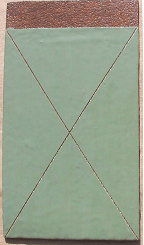 |
| Products |
|
|
|
|
|
|
|
|
 |
Products |
  Products Information Products Information Products Products |
|
|
Untitled Document
|
| FREE MASTIC G-316 |
 | |
|
| CATEGORY |
For construction / industrial / heavy anti-corrosive / adhesion / special epoxy |
|
 | |
|
| OVERVIEW |
nontoxic, solvent-free epoxy (for both primer and coating) |
|
 | |
|
| USE |
apply to oil, moisture, rust and FRP |
|
 | |
|
| COLOR |
bright green, grey, reddish brown, blue, olive green |
|
 | |
|
| DOWNLOAD |
  |
|
 | |
| |
|
| |
| PRODUCT INFORMATION |
|
|
G-316 is a low viscosity, non solvent type epoxy mastic entirely different from ordinary products.
It was born from new concept based on plastic alloy technology ( polymer blend ) and exhibits very unique, extraordinary and unexpected performance.
The viscosity of mixed mastic is in medium range and looks like flowing but when applied to the wall it shows thixo tropic property and forms very thick film, leading to good work condition.
Meanwhile our company has been producing many items for lining pot water tank, boiler tank and for coating rusted steel structures, wetted concrete, hardener treated concrete, chemical proof and repairing ballast tank but now we can unify these items only to one Free mastic G-316 displaying better performances with better workability and simplicity.
We hope the versatile Free mastic G-316 will give you more opportunities and new experiences. |
| |
 Feature Feature |
1. Good adhesion to steel and non ferrous metals that difficult to get good adhesion like aluminum, stainless steel, lead, nickel, titanium, and even to FRP that adhesion was almost impossible like SMC, BMC, and hand layup.
Good adhesion and durability to glass, tile, marble.
2. Makes an hydrophobic structures between molecular chains through the plastic alloy technics and exhibit an extraordinary water proofing property.
3. The coated film is hard, flexible, and resistant to thermal shock ( no fault when the coated panel quenched to 10℃ water from 200℃ oven )
4. Neither eroded by water nor contaminate water.
5. Withstand to boiling water ( 500㎛ film on 1㎜ stainless steel plate showed no fault after 30days in boiling water dipped in half and dried. )
6. Good affinity to rust.
7. Applied on the rusted surface directly. Stop the mechanism of rusting via suppressing the penetration of humidity and air and exhibits excellent antirusting property.
8. Smooth and slick surface.
9. Good wetting on water wetted concrete or rust and shows good workability and performances. ( underwater coating is possible for non porous surface and displays same performances to ordinary coating )
10. Good affinity with mineral oil and have excellent workability on oily concrete or rust and displays equal or better performances to dry, clean surface.
11. Good chemical proof properties
12. Good electrical properties.
13. Curable at low temperature ( 4℃ )
14. Good adhesion to itself.
15. Good adhesion of epoxy, acryl urethane paint on G-316 |
| |
 Specification Specification |
viscosity
- (R) : thixotropic medium viscosity
- (H) : 170 ± 20 cps ( 25℃ )
specific gravity
- (R) : 1.43 ± 0.05
- (H) : 1.03 ± 0.03
non volatile - 97 % (contains no solvent)
mixing ratio - (R) + (H) = 5 + 1 ( by weight )
pot life
- 50 mins ( non solvent, 20℃, 100g )
- 60 mins ( tolune 4% to mixture, 20℃, 100g )
- 40 mins ( ethanol 4% to mixture, 20℃, 100g )
tack free
- 4 hrs (20℃, non solvent )
- 12 hrs (10℃, non solvent )
- 14 hrs (8℃, non solvent )
- 18 hrs (4℃, non solvent )
full cure - 7 days ( 20℃ )
viscosity of mixture
- 6800 cps ( non solvent, 25℃ )
- 2600 cps ( TL 4 % to mixture, 25℃ )
- 570 cps (TL 8 % to mixture, 25℃ )
- 2400 cps ( EtOH 4% to mixture, 25℃ )
film thickness( maximum )
- 1m/m (non solvent, brush coat )
- 600㎛ ( TL 3% to mixture, brush coat )
- 500㎛ ( TL 4% to mixture, brush coat )
color - blue, gray, moth green, light green, dark brown
coverage - 137 g /㎡ ( 100㎛ dried film, theoretical ) |
| |
 Physical, Chemical property Physical, Chemical property |
lap shear
- 124 kg/㎠ (mild steel - mild steel , destruction of film)
- 137 kg/㎠ (oil wetted mild steel - oil wetted mild steel ,
destruction of film)
T peeling - 4.4 kg/㎝ (mild steel - mild steel , destruction of film)
cross cut - 100/100 (50㎛ film)
hardness - 69 (shore D)
gloss - 85 (60°)
flexibility - Ok (10m/m mandrel, 70㎛)
Erichsen - A 8.1 (70㎛ steel plate)
thermal shock - Ok(200℃ air → 10℃ water quench, 3 times, 100㎛)
water proof (boiling) - no defects (30days, in boiling water, half dipped
200㎛, RT cured for 7 days)
chemical resistance
- 75% H2SO4 (no defects, RT, 3 months)
- 10% HAc (blister, RT, 3 months)
- 30% HNO3 (blister, RT, 3 months)
- 36% HCl (no defects, RT, 3 months)
- 30% NaOH (no defects, RT, 3 months)
surface resistivity - > 1x1015 Ω cm (20℃)
salt fog resistance - no defects (given in table)
leaching test - no defects (given in table) |
| |
 leaching test leaching test |
Free mastic G- 316 / 11.08.2002
| Test item |
Unit |
Spec |
Result |
Test method |
| turbidity |
degree |
0.5 below |
0.5 below |
KSD8502:1994 |
| colour |
degree |
1 below |
1 below |
KSD8502:1994 |
consumption of
KMnO4 |
mg/L |
2 below |
1 |
KSD8502:1994 |
| decreased quantity of total residual chlorine |
mg/L |
0.7 |
0.4 |
KSD8502:1994 |
| odor |
- |
no defects |
no defects |
KSD8502:1994 |
| taste |
- |
no defects |
no defects |
KSD8502:1994 |
| cyan |
mg/L |
not detected |
not detected |
KSD8502:1994 |
| phenol |
mg/L |
not detected |
not detected |
KSD8502:1994 |
| amines |
mg/L |
not detected |
not detected |
KSD8502:1994 |
| epichlorohydrine |
mg/L |
not detected |
not detected |
KSD8502:1994 |
| toluene disocyanate |
mg/L |
not detected |
not detected |
KSD8502:1994 |
for quality control, KOTRIC |
| |
 peeling after salt spray test peeling after salt spray test |
Free mastic G-316 / 11.08.2002
| Test item |
Unit |
Sample |
Result |
Test Method |
| peeling after salt spray test(500hrs) |
- |
rusted steel plate ordinary |
no defects |
KS D 9502 : 1992 |
| - |
rusted steel plate
water wetted |
" |
" |
| - |
rusted steel plate
oil wetted |
" |
" |
| - |
steel plate |
|
|
for quality control, KOTRIC
| dried rust |
applied G-316 |
after salt fog 500 hrs |
 |
 |
 |
| water wetted rust |
applied G-316 |
after salt fog 500 hrs |
 |
 |
 |
| oil wetted rust |
applied G-316 |
after salt fog 500 hrs |
 |
 |
 |
|
| |
 Typical usage Typical usage |
[1] Lining for potable water tank
Many types of epoxy paints have been used for many types of tank for potable water.
They are classified to solvent type, emulsion type and non solvent type and have it's own merits and demerits.
G-316 has many surpassing features in performances comparing to
ordinary paints as given in table.
|
Emulsion |
Solvent
type |
Ordinary non solvent type |
G-316 |
| workability(vis) |
O |
O |
Δ |
O |
| safety |
O |
x |
O |
O |
| film thickness |
thin |
thin |
thick |
thick |
| cure speed |
x |
Δ |
O |
O |
| water proof |
⌈ - O |
O |
O |
Θ |
adhesion to
substrate |
conditional |
conditional |
conditional |
Θ |
| ease of cleaning |
Δ |
⌈ |
Δ |
O |
| cost |
Δ |
Δ |
Δ |
O |
(A) Concrete tank
Concrete contains large quantity of water at new state or not and the contained water arouse many troubles in application and performance, the solvent type paint can't be applied on wetted surface and emulsion type can be considered but to build expected thickness 3 ~ 4 times of application is needed.
More over the drying process is necessary to every application resulting in high cost.
G-316 is applied to wetted concrete directly with good workability and displays excellent performances.
The thickness of film can be controlled to 1mm maximum.
(B) FRP tank
For repairing or decoration a proper paint was demanded for inside and outside of FRP tank but majority of the unsaturated polyester resin contain volume of wax and makes the surface of FRP difficult to be coated.
G-316 shows good adhesion to FRP ( Hand layup, SMC, BMC ) and recommended for coating FRP tank.
(C) Steel tank
The inner surface of used tank is partly rusted and wetted with water always because of high humidity.
The steel plate of newly made tank is covered with oil and difficult to be removed entirely.
The oil, rust and high humidity is an serious obstacle to application but G-316 shows excellent compability with rust, oil and water on the surface and shows good adhesion.
G-316 is a solution to steel tank lining of harsh environment.
(D) Stainless steel tank
Stainless steel is resistant to various chemicals and rust free and is fit for potable water tank but the evaporated chlorine from tap water corrode the upper and ceiling part.
The welded line is more susceptible to water and chlorine and easily oxidized.
The epoxy paint should adhere tightly to stainless steel and protect from water, chlorine and have good workability.
G-316 satisfies these all conditions.
[2] Lining for boiling water tank
The boiling water has very big activity and imparts big energies to the lining of the tank.
These energies penetrate the membrane and accompanied by oxidation reaction, hydration , making cleavage between molecules, forming local cells results in cracking, lifting and failure of lining.
When the operation stopped the temperature of tank returns to room temperature and the strain of thermal shock is accumulated in membrane and make causes of lifting.
These harsh conditions make the lining for boiling water different from ordinary lining.
G-316 can be solution to the lining for boiling water
[3] Underwater coating
G-316 has hydrophobic property basically but also has a little hydrophilic and this double faced property makes it possible.
When G-316 was applied the liquid membrane drives out the water on the surface but it absorbs the remained water itself too and this process promote the wetting of mastic.
But on the porous substrate the wetting of mastic is hindered by water supplied continuously from pores.
[4] Non ferrous metals
Generally speaking the paint shows no good adhesion to the non ferrous metals like stainless steel, aluminum, galvanized steel, etc.
The reason is low surface energy of non ferrous metals and to overcome this phenomenon the surface must be oxidized by etching or pickling with acid.
Without any treatment G-316 displays good adhesion on these metals even at the contaminated condition with oil or water.
[5] Coating for FRP
The matrix of conventional FRP is unsaturated polyester resin containing wax preventing the disturbance of oxygen in the air and this wax makes the paint difficult to adhere to itself.
G-316 has good affinity to the surface of waxed FRP caused by excellent wetting ability resulting in good adhesion.
But the main structure of G-316 is DGEBA type epoxy resin and under the UV light colors of paint changes to yellow side and the surface can be chalked under long exposure to the sun light.
The non-yellowing type paint must be applied to the top of G-316 for decorating purpose under sun light.
[6] Lining for concrete floor contaminated with oil or water.
The concrete floor of factory or facility using the oil in process is contaminated severely with oils.
The oil comes out from saturated inner part of concrete after the oil of surface is removed and this phenomenon makes coating or lining on the
oil saturated concrete impossible.
But G-316 shows extraordinary affinity wetting on the oily or water wetted surface and adheres to concrete directly.
G-316 is a solution to this problem.
[7] Coating on the rusted steel
In the fields the removal of the rust on the steel structure is not simple in the sight of economic , facility and environment.
It's most desirable for the paint applied on the rust directly without removing the rust completely from surface.
G-316 can be applied on the rusted surface after only removing the scales and dusts with wire brush.
The matrix of G-316 penetrates into the rust with good wetting and after cure it form a tough and hydrophobic barrier film restricting all access of oxygen and water forming the circuit of local cells.
Moreover G-316 can be applied on the water wetted rust or oil wetted( oil contaminated )rust directly with good wetting and exhibits extraordinary performances.
According to our test the coating on the oil wetted rust showed better wetting and better anti corrosion performance and on the water wetted rust showed almost same performance comparing to the coating on the dried ordinary rust.
Example test
Prepare the steel plate rusted heavily and remove the scales and dust with wire brush. Cut in three pieces and pretreat like below.
D : dried
W : dip in water for 30 minutes, keep the state of wetted, not dried before coating
P : penetrate with ordinary petroleum oil and wipe out the excess
Dilute the mixed G-316 with toluene and coat with brush building the thickness about 100~150µm.
Repeat the same work after first coat was cured for 3 days ( 20°C ).
Cure the panel fully for 10 days ( 20°C).
Cross cut the film of test panel to the shape of ♦ exposing the bare metal and dip half in 5% salt water bath keeping the temperature 50°C for 30 days, after washing exposed in the air for 60 days.
Checked the state at the upper part, draft part, underwater part.
Result
D : There was no lifting, peeling, a few small blisters were seen along the cutting line at upper part.
W : Almost same to D .
P : No blisters, looking better than D , W .
[8] Molding, Adhesives
G-316 contains no solvent , 100% solid, low viscosity mastic so can be used for molding the electric, electronic parts of general purpose.
For sealing the gap or bonding between materials hard to adhere like FRP-glass, FRP-stainless steel. G-316 can be a good solution.
G-316 can be used itself or can be made to putty form by adding proper quantity of fillers like talc, calcium carbonate, fibers, etc.
For bonding materials contaminated with mineral oil G-316 plays excellent performance.
|
| |
 Remarks for application Remarks for application |
• Lining for potable water tank
1. Check the state of surface, remove debris, seal the crack, holes with
G-316 putty if needed. Water cleaning is possible
2. Use Ethanol under 10% to mixture for airless spray.
3. Control the quantity of ethanol according to the designed thickness of
film.
4. Ventilate and blow out ethanol to outside.
5. Apply on the dried, water wetted, oil wetted surface directly.
6. Water can be filled after 3 days of application ( 20℃ ) but quantity of
ethanol and temperature can be variables.
• Under water lining
1. Apply the mastic ( 100% solid ) without adding thinner.
2. Apply with the spatula of wide span or bristle brush.
• Lining for oil wetted or water wetted concrete
1. Remove the oily dirt sticked to the concrete by wire brush to expose the surface of concrete.
2. Add toluene under 8% to the mixture, apply with airless spray, roller or brush.
3. Control the thickness.
• Coating for rusted steel ( dried, water wetted, oil wetted )
1. Remove the scales, dust, loose rust with wire brush
2. Add toluene under 8% to the mixture properly and apply with airless spray or roller.
3. Control the film thickness to cover the rust enough so the upper part of rust can't be seen. |
| |
 Notes for attention Notes for attention |
1. Keep the mixing ratio exactly ( R : H = 5 : 1 )
The cure speed depends on the temperature not by increasing the
quantity of hardener.
2. Agitate well with powered stirrer to be homogeneous state, paying
attention at bottom, wall and corner side.
3. Not applicable on the thermoplastics, rubber, magnesium alloy and zinc.
4. Have good affinity to mineral oil but not to silicone oil.
The silicon oil on the surface used as mold release must be removed
entirely ( especially on FRP )
5. Ethanol, toluene, thinner#5212 is recommended only for thinner.
Other formulated thinners, xylene, cellosolves, ketones, alcohols are not recommended because of bad effects like sweating, tackiness, softening.
Toluene should be added under 8% to the mixture to get good result
and if not some sweating may be remained on the surface.
6. Best gloss result from application without thinner and least gloss from
spraying with volumes of thinner.
7. G-316 may be discolored or speckled under long exposure to sunlight. |
| |
|
| |
src=../shop/eimages2/img/$row3[image] width=140 height=105 border=0> |
|